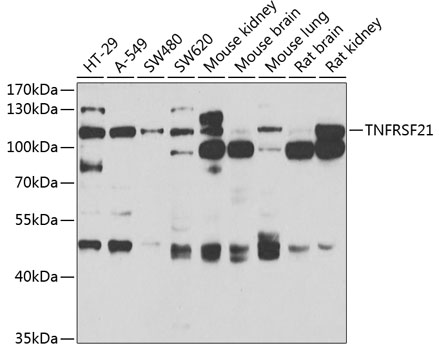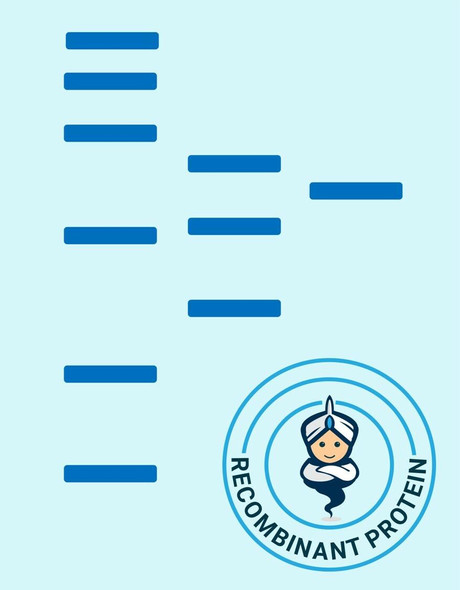Immunology Antibodies 2
Anti-TNFRSF21 Antibody (CAB7365)
- SKU:
- CAB7365
- Product Type:
- Antibody
- Reactivity:
- Human
- Reactivity:
- Mouse
- Reactivity:
- Rat
- Host Species:
- Rabbit
- Isotype:
- IgG
- Antibody Type:
- Polyclonal Antibody
- Research Area:
- Immunology
Description
| Antibody Name: | Anti-TNFRSF21 Antibody |
| Antibody SKU: | CAB7365 |
| Antibody Size: | 20uL, 50uL, 100uL |
| Application: | WB |
| Reactivity: | Human, Mouse, Rat |
| Host Species: | Rabbit |
| Immunogen: | Recombinant fusion protein containing a sequence corresponding to amino acids 371-655 of human TNFRSF21 (NP_055267.1). |
| Application: | WB |
| Recommended Dilution: | WB 1:500 - 1:2000 |
| Reactivity: | Human, Mouse, Rat |
| Positive Samples: | HT-29, A-549, SW480, SW620, Mouse kidney, Mouse brain, Mouse lung, Rat brain, Rat kidney |
| Immunogen: | Recombinant fusion protein containing a sequence corresponding to amino acids 371-655 of human TNFRSF21 (NP_055267.1). |
| Purification Method: | Affinity purification |
| Storage Buffer: | Store at -20'C. Avoid freeze / thaw cycles. Buffer: PBS with 0.02% sodium azide, 50% glycerol, pH7.3. |
| Isotype: | IgG |
| Sequence: | RKSS RTLK KGPR QDPS AIVE KAGL KKSM TPTQ NREK WIYY CNGH GIDI LKLV AAQV GSQW KDIY QFLC NASE REVA AFSN GYTA DHER AYAA LQHW TIRG PEAS LAQL ISAL RQHR RNDV VEKI RGLM EDTT QLET DKLA LPMS PSPL SPSP IPSP NAKL ENSA LLTV EPSP QDKN KGFF VDES EPLL RCDS TSSG SSAL SRNG SFIT KEKK DTVL RQVR LDPC DLQP IFDD MLHF LNPE ELRV IEEI PQAE DKLD RLFE IIGV KSQE ASQT LLDS VYSH LPDL L |
| Gene ID: | 27242 |
| Uniprot: | O75509 |
| Cellular Location: | Cell membrane, Single-pass type I membrane protein |
| Calculated MW: | 71kDa |
| Observed MW: | 110kDa |
| Synonyms: | TNFRSF21, BM-018, CD358, DR6 |
| Background: | This gene encodes a member of the tumor necrosis factor receptor superfamily. The encoded protein activates nuclear factor kappa-B and mitogen-activated protein kinase 8 (also called c-Jun N-terminal kinase 1), and induces cell apoptosis. Through its death domain, the encoded receptor interacts with tumor necrosis factor receptor type 1-associated death domain (TRADD) protein, which is known to mediate signal transduction of tumor necrosis factor receptors. Knockout studies in mice suggest that this gene plays a role in T-helper cell activation, and may be involved in inflammation and immune regulation. |
| UniProt Protein Function: | DR6: May activate NF-kappa-B and promote apoptosis. May activate JNK and be involved in T-cell differentiation. Required for both normal cell body death and axonal pruning. Trophic-factor deprivation triggers the cleavage of surface APP by beta-secretase to release sAPP-beta which is further cleaved to release an N- terminal fragment of APP (N-APP). N-APP binds TNFRSF21 triggering caspase activation and degeneration of both neuronal cell bodies (via caspase-3) and axons (via caspase-6). Associates with TRADD. Interacts with N-APP. Highly expressed in heart, brain, placenta, pancreas, lymph node, thymus and prostate. Detected at lower levels in lung, skeletal muscle, kidney, testis, uterus, small intestine, colon, spleen, bone marrow and fetal liver. Very low levels were found in adult liver and peripheral blood leukocytes. |
| UniProt Protein Details: | Protein type:Apoptosis; Membrane protein, integral; Receptor, cytokine Chromosomal Location of Human Ortholog: 6p21.1 Cellular Component: axon; integral to plasma membrane; plasma membrane; intrinsic to plasma membrane Molecular Function:protein binding Biological Process: myelination; neuron apoptosis; adaptive immune response; negative regulation of T cell proliferation; negative regulation of myelination; apoptosis; regulation of oligodendrocyte differentiation; B cell apoptosis; negative regulation of B cell proliferation; cellular lipid metabolic process; T cell receptor signaling pathway; humoral immune response |
| NCBI Summary: | This gene encodes a member of the tumor necrosis factor receptor superfamily. The encoded protein activates nuclear factor kappa-B and mitogen-activated protein kinase 8 (also called c-Jun N-terminal kinase 1), and induces cell apoptosis. Through its death domain, the encoded receptor interacts with tumor necrosis factor receptor type 1-associated death domain (TRADD) protein, which is known to mediate signal transduction of tumor necrosis factor receptors. Knockout studies in mice suggest that this gene plays a role in T-helper cell activation, and may be involved in inflammation and immune regulation. [provided by RefSeq, Jul 2013] |
| UniProt Code: | O75509 |
| NCBI GenInfo Identifier: | 21264087 |
| NCBI Gene ID: | 27242 |
| NCBI Accession: | O75509.1 |
| UniProt Related Accession: | O75509 |
| Molecular Weight: | Observed: 72 kDaPredicted: 72 kDa |
| NCBI Full Name: | Tumor necrosis factor receptor superfamily member 21 |
| NCBI Synonym Full Names: | TNF receptor superfamily member 21 |
| NCBI Official Symbol: | TNFRSF21 |
| NCBI Official Synonym Symbols: | DR6; CD358; BM-018 |
| NCBI Protein Information: | tumor necrosis factor receptor superfamily member 21 |
| UniProt Protein Name: | Tumor necrosis factor receptor superfamily member 21 |
| UniProt Synonym Protein Names: | Death receptor 6; CD_antigen: CD358 |
| UniProt Gene Name: | TNFRSF21 |
| UniProt Entry Name: | TNR21_HUMAN |
View AllClose







